Azure Backup offline backup by using Azure Data Box
This article describes how you can use Azure Data Box to seed large initial backup data offline from the MARS Agent to a Recovery Services vault.
You can use Azure Data Box to seed your large initial Microsoft Azure Recovery Services (MARS) backups offline (without using network) to a Recovery Services vault. This process saves time and network bandwidth that would otherwise be consumed moving large amounts of backup data online over a high-latency network. Offline backup based on Azure Data Box provides two distinct advantages over offline backup based on the Azure Import/Export service:
- There's no need to procure your own Azure-compatible disks and connectors. Azure Data Box ships the disks associated with the selected Data Box SKU.
- Azure Backup (MARS Agent) can directly write backup data onto the supported SKUs of Azure Data Box. This capability eliminates the need for you to provision a staging location for your initial backup data. You also don't need utilities to format and copy that data onto the disks.
Support matrix
This section explains the supported scenarios.
Supported platforms
The process to seed data from the MARS Agent by using Azure Data Box is supported on the following Windows SKUs.
| OS | SKU |
|---|---|
| Workstation | |
| Windows 10 64 bit | Enterprise, Pro, Home |
| Windows 8.1 64 bit | Enterprise, Pro |
| Windows 8 64 bit | Enterprise, Pro |
| Windows 7 64 bit | Ultimate, Enterprise, Professional, Home Premium, Home Basic, Starter |
| Server | |
| Windows Server 2022 64 bit | Standard, Datacenter, Essentials |
| Windows Server 2019 64 bit | Standard, Datacenter, Essentials |
| Windows Server 2016 64 bit | Standard, Datacenter, Essentials |
| Windows Server 2012 R2 64 bit | Standard, Datacenter, Foundation |
| Windows Server 2012 64 bit | Datacenter, Foundation, Standard |
| Windows Storage Server 2016 64 bit | Standard, Workgroup |
| Windows Storage Server 2012 R2 64 bit | Standard, Workgroup, Essential |
| Windows Storage Server 2012 64 bit | Standard, Workgroup |
| Windows Server 2008 R2 SP1 64 bit | Standard, Enterprise, Datacenter, Foundation |
| Windows Server 2008 SP2 64 bit | Standard, Enterprise, Datacenter |
Backup data size and supported Data Box SKUs
| Backup data size (post-compression by MARS)* per server | Supported Azure Data Box SKU |
|---|---|
| <=7.2 TB | Azure Data Box disk |
| >7.2 TB and <=80 TB** | Azure Data Box (100 TB) |
*Typical compression rates vary between 10% and 20%.
**If you expect to have more than 80 TB of initial backup data for a single MARS server, contact AskAzureBackupTeam@microsoft.com.
Important
Initial backup data from a single server must be contained within a single Azure Data Box instance or Azure Data Box disk and can't be shared between multiple devices of the same or different SKUs. But an Azure Data Box device can contain initial backups from multiple servers.
Prerequisites
Azure subscription and required permissions
- The process requires an Azure subscription.
- The process requires that the user designated to perform the offline backup policy is an owner of the Azure subscription.
- The Data Box job and the Recovery Services vault (to which the data needs to be seeded) are required to be in the same subscriptions.
- We recommend that the target storage account associated with the Azure Data Box job and the Recovery Services vault are in the same region. However, this isn't necessary.
- Ensure that you have the necessary permissions to create the Microsoft Entra application. The Offline Backup workflow creates a Microsoft Entra application in the subscription associated with the Azure Storage account. This application allows the Azure Backup Service a secure and scoped access to the Azure Import Service, required for the Offline Backup workflow.
Get Azure PowerShell 3.7.0
This is the most important prerequisite for the process. Before you install Azure PowerShell, version 3.7.0, perform the following checks.
Step 1: Check the PowerShell version
Open Windows PowerShell, and run the following command:
Get-Module -ListAvailable AzureRM*If the output displays a version higher than 3.7.0, do "Step 2." Otherwise, skip to "Step 3."
Step 2: Uninstall the PowerShell version
Uninstall the current version of PowerShell.
Remove the dependent modules by running the following command in PowerShell:
foreach ($module in (Get-Module -ListAvailable AzureRM*).Name |Get-Unique) { write-host "Removing Module $module" Uninstall-module $module }To ensure the successful deletion of all the dependent modules, run the following command:
Get-Module -ListAvailable AzureRM*
Step 3: Install PowerShell version 3.7.0
After you've verified that no AzureRM modules are present, install version 3.7.0 by using one of the following methods:
- From GitHub, use this link.
Or you can:
Run the following command in the PowerShell window:
Install-Module -Name AzureRM -RequiredVersion 3.7.0
Azure PowerShell could have also been installed by using an MSI file. To remove it, uninstall it by using the Uninstall programs option in Control Panel.
Order and receive the Data Box device
The offline backup process using MARS and Azure Data Box requires the Data Box devices to be in a Delivered state before you trigger offline backup by using the MARS Agent. To order the most suitable SKU for your requirement, see Backup data size and supported Data Box SKUs. Follow the steps in Tutorial: Order an Azure Data Box disk to order and receive your Data Box devices.
Important
Don't select BlobStorage for the Account kind. The MARS Agent requires an account that supports page blobs, which isn't supported when BlobStorage is selected. Select Storage V2 (general purpose v2) as the Account kind when you create the target storage account for your Azure Data Box job.
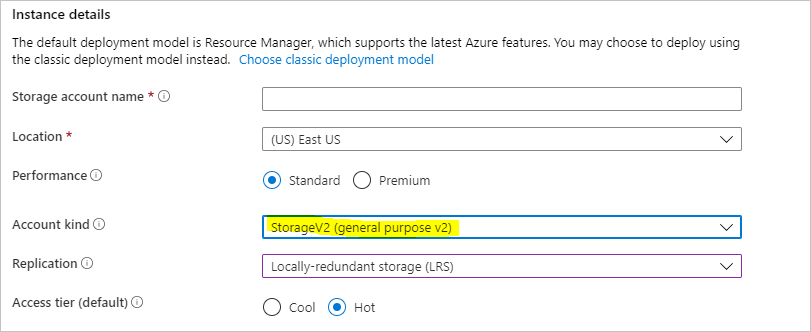
Install and set up the MARS Agent
Make sure you uninstall any previous installations of the MARS Agent.
Download the latest MARS Agent from this website.
Run MARSAgentInstaller.exe, and do only the steps to install and register the agent to the Recovery Services vault where you want your backups to be stored.
Note
The Recovery Services vault must be in the same subscription as the Azure Data Box job.
After the agent is registered to the Recovery Services vault, follow the steps in the next sections.
Set up Azure Data Box devices
Depending on the Azure Data Box SKU you ordered, do the steps covered in the appropriate sections that follow. The steps show you how to set up and prepare the Data Box devices for the MARS Agent to identify and transfer the initial backup data.
Set up Azure Data Box disks
If you ordered one or more Azure Data Box disks (up to 8 TB each), follow the steps mentioned here to unpack, connect, and unlock your Data Box disk.
Note
It's possible that the server with the MARS Agent doesn't have a USB port. In that situation, you can connect your Azure Data Box disk to another server or client and expose the root of the device as a network share.
Set up Azure Data Box
If you ordered an Azure Data Box instance (up to 100 TB), follow the steps here to set up your Data Box instance.
Mount your Azure Data Box instance as a Local System
The MARS Agent operates in the Local System context, so it requires the same level of privilege to be provided to the mount path where the Azure Data Box instance is connected.
To ensure you can mount your Data Box device as a Local System by using the NFS protocol:
Enable the client for the NFS feature on the Windows server that has the MARS Agent installed. Specify the alternate source WIM:D:\Sources\Install.wim:4.
Download PsExec from the Sysinternals page to the server with the MARS Agent installed.
Open an elevated command prompt, and run the following command with the directory that contains PSExec.exe as the current directory.
psexec.exe -s -i cmd.exeThe command window that opens because of the previous command is in the Local System context. Use this command window to execute the steps to mount the Azure page blob share as a network drive on your Windows server.
Follow the steps in Connect to Data Box to connect your server with the MARS Agent to the Data Box device via NFS. Run the following command on the Local System command prompt to mount the Azure page blobs share.
mount -o nolock \\<DeviceIPAddress>\<StorageAccountName_PageBlob X:After the share is mounted, check to see if you can access X: from your server. If you can, continue with the next section of this article.
Transfer initial backup data to Azure Data Box devices
Open the Microsoft Azure Backup application on your server.
On the Actions pane, select Schedule Backup.
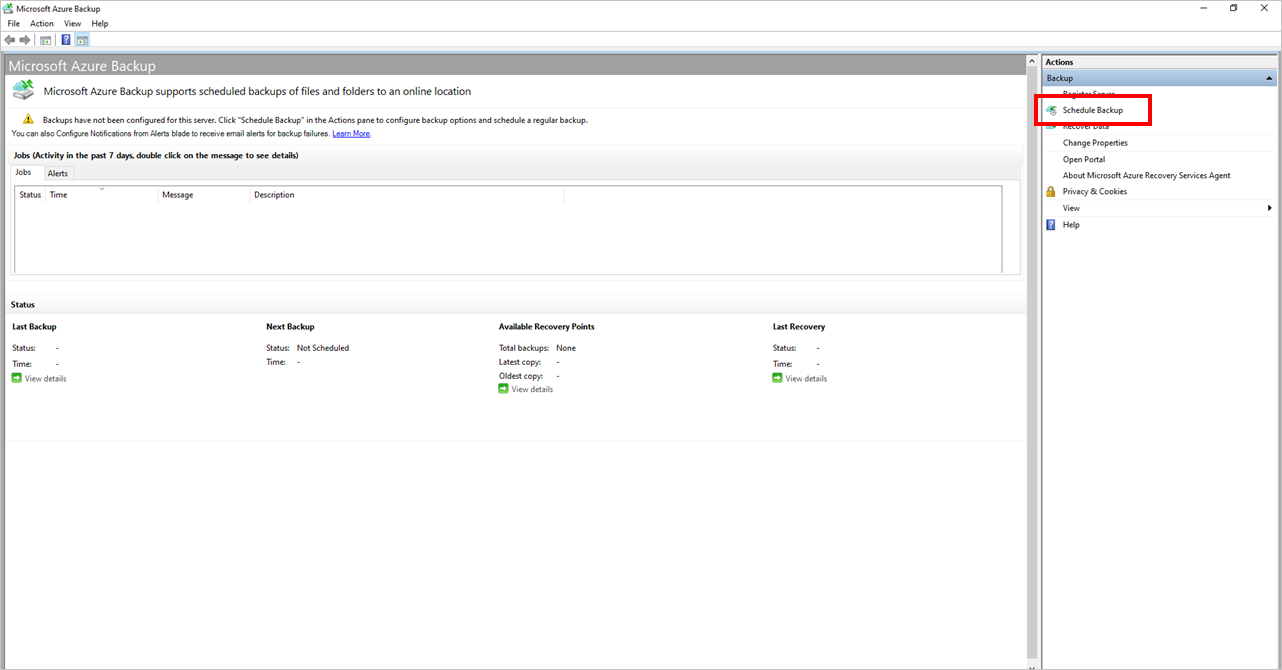
Follow the steps in the Schedule Backup Wizard.
Add items by selecting the Add Items button. Keep the total size of the items within the size limits supported by the Azure Data Box SKU that you ordered and received.
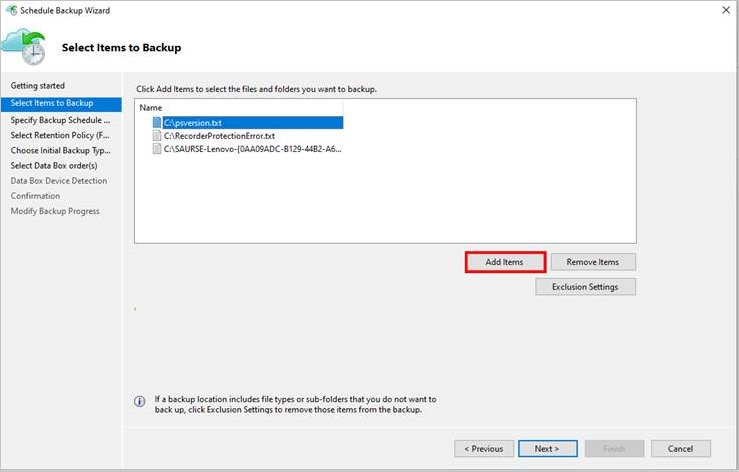
Select the appropriate backup schedule and retention policy for Files and Folders and System State. System state is applicable only for Windows Servers and not for Windows clients.
On the Choose Initial Backup Type (Files and Folders) page of the wizard, select the option Transfer using Microsoft Azure Data Box disks and select Next.
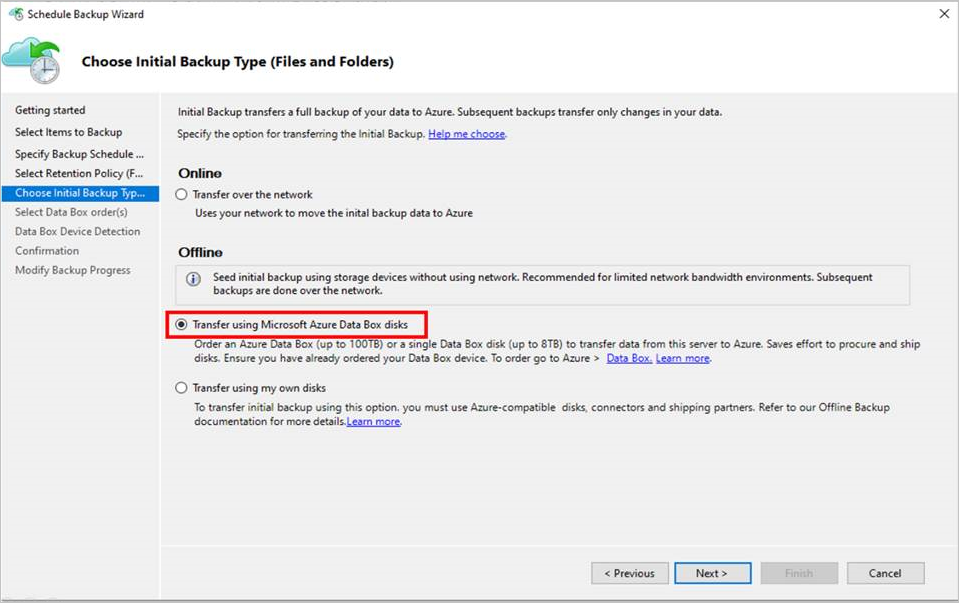
Sign in to Azure when prompted by using the user credentials that have Owner access on the Azure subscription. After you succeed in doing so, you should see a page that resembles this one.
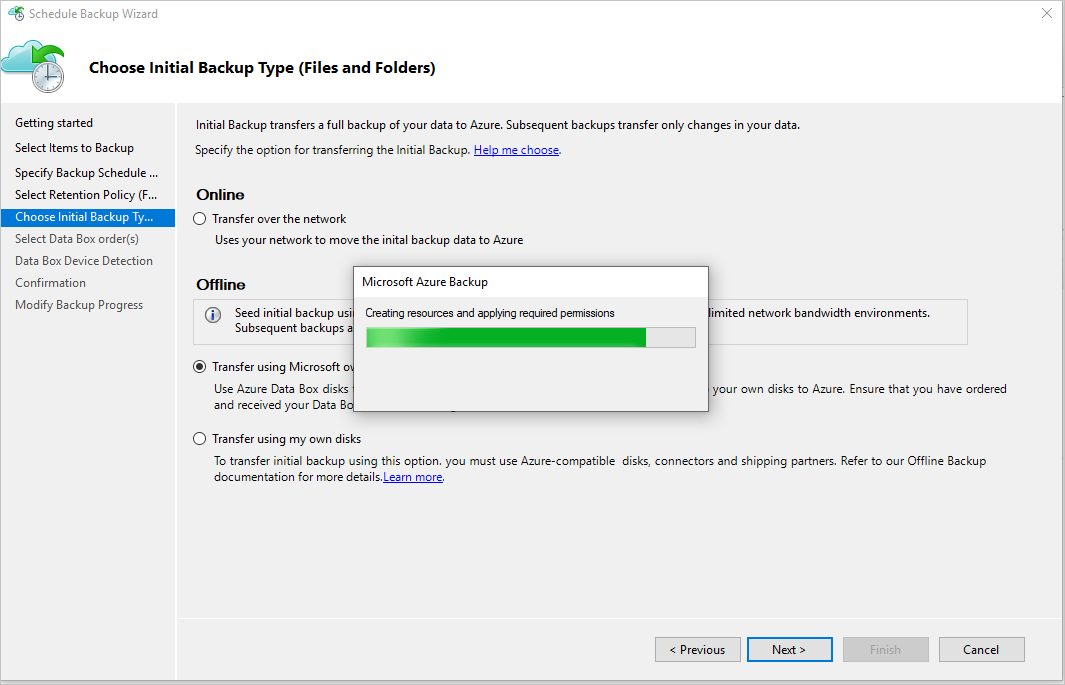
The MARS Agent then fetches the Data Box jobs in the subscription that are in the Delivered state.
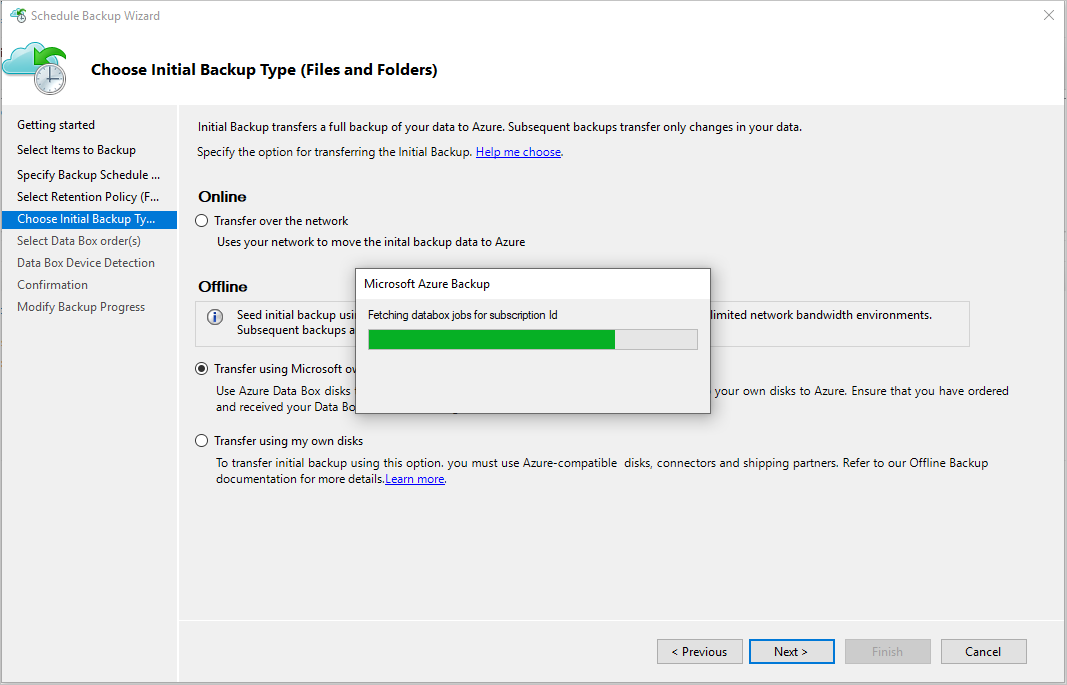
Select the correct Data Box order for which you've unpacked, connected, and unlocked your Data Box disk. Select Next.
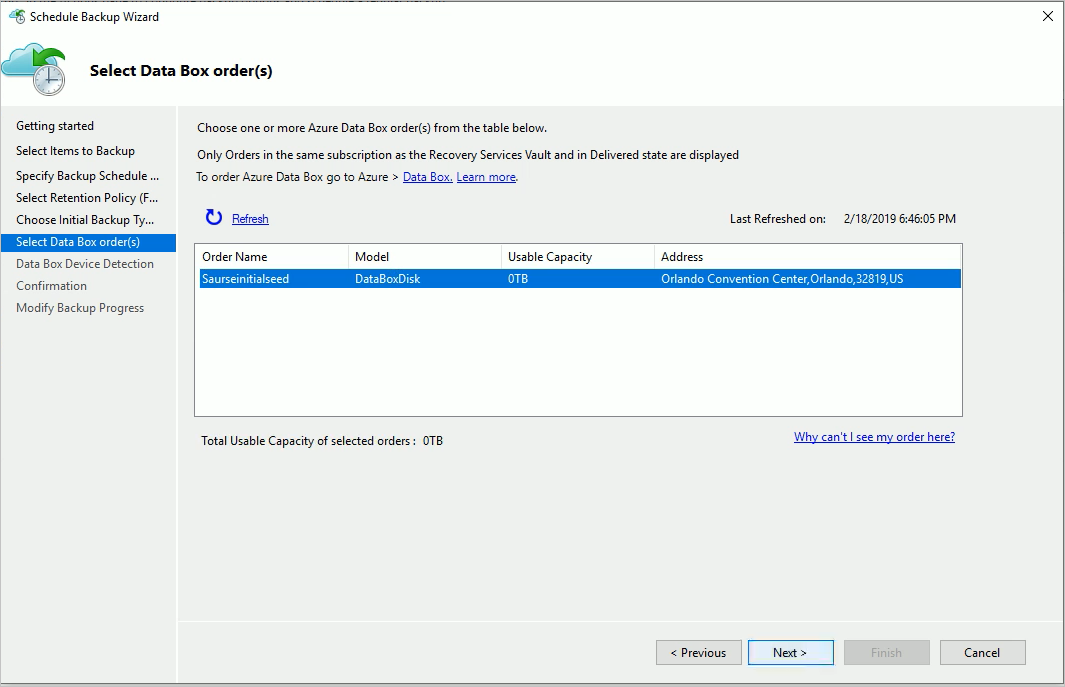
Select Detect Device on the Data Box Device Detection page. This action makes the MARS Agent scan for locally attached Azure Data Box disks and detect them.
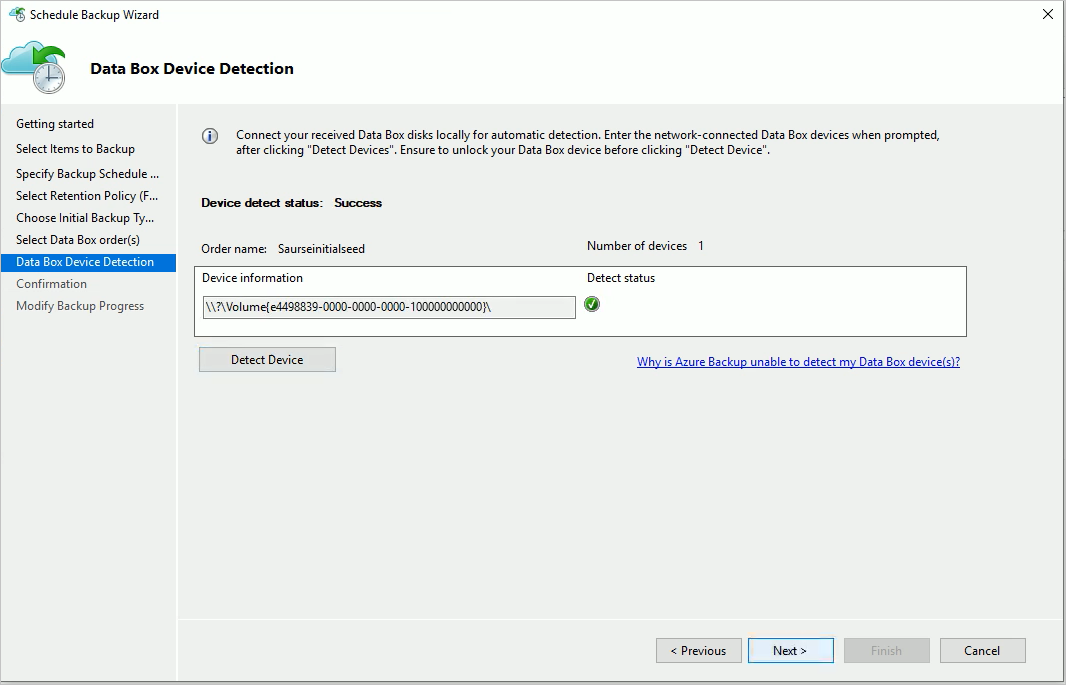
If you connected the Azure Data Box instance as a network share (because of unavailability of USB ports or because you ordered and mounted the 100-TB Data Box device), detection fails at first. You're given the option to enter the network path to the Data Box device.
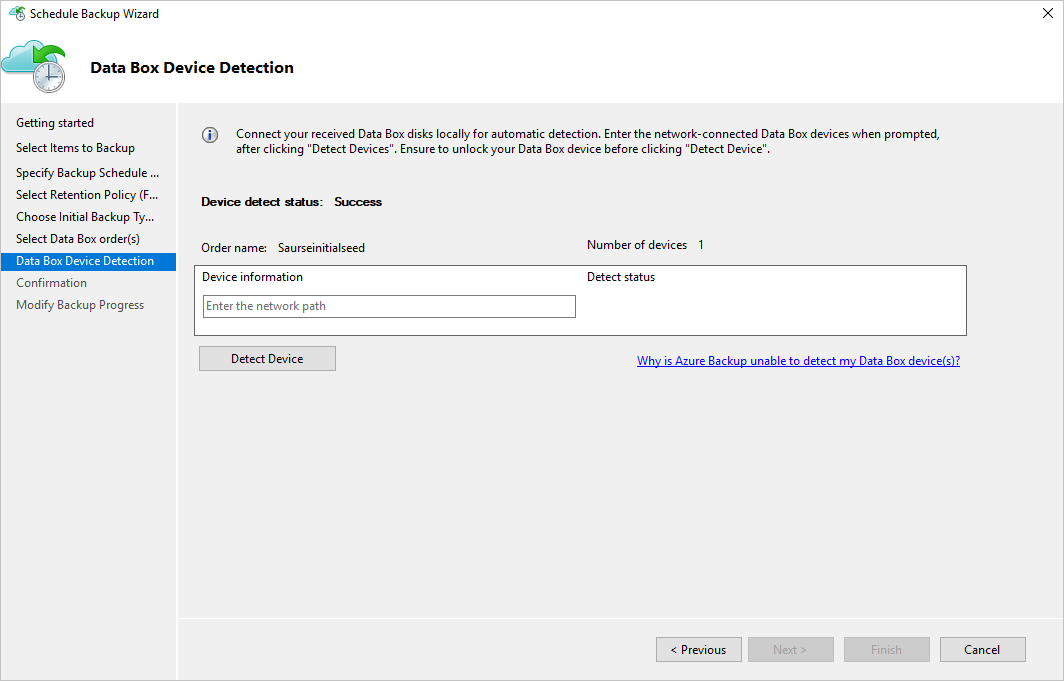
Important
Provide the network path to the root directory of the Azure Data Box disk. This directory must contain a directory by the name PageBlob.
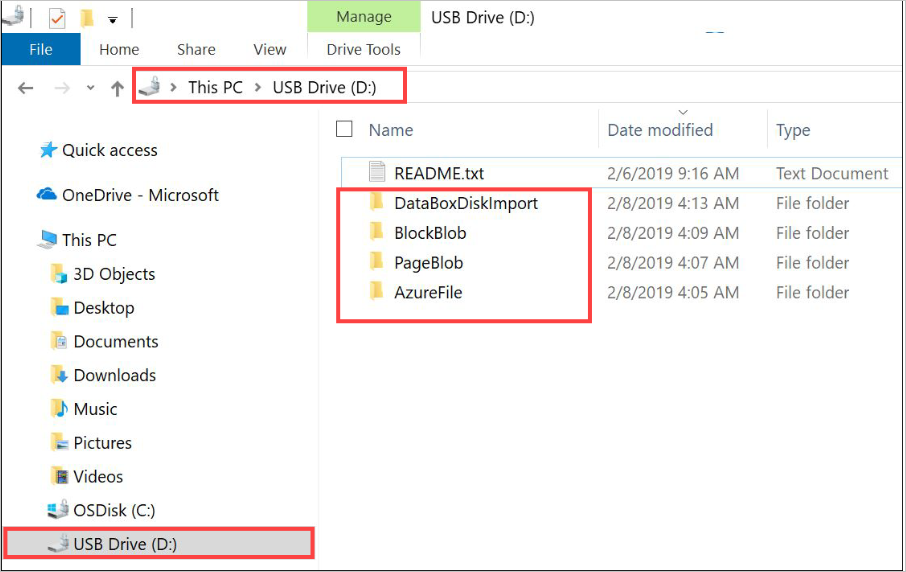
For example, if the path of the disk is
\\mydomain\myserver\disk1\and disk1 contains a directory called PageBlob, the path you enter on the MARS Agent wizard page is\\mydomain\myserver\disk1\.If you set up an Azure Data Box 100-TB device, enter
\\<DeviceIPAddress>\<StorageAccountName>_PageBlobas the network path to the device.Select Next, and select Finish on the next page to save the backup and retention policy with the configuration of offline backup by using Azure Data Box.
The following page confirms that the policy is saved successfully.
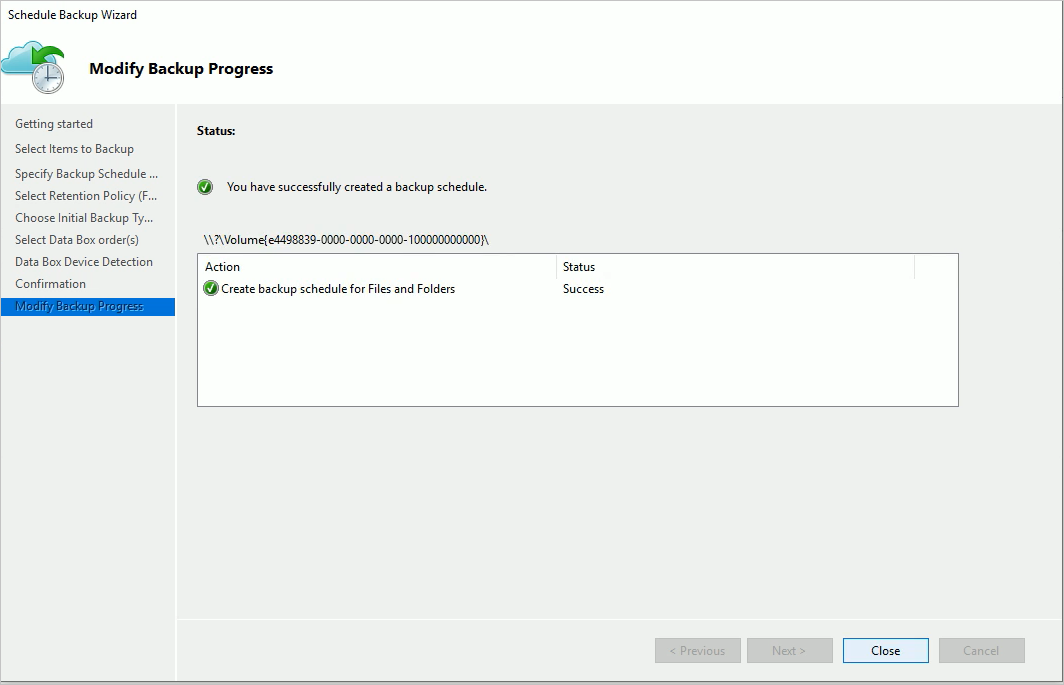
Select Close on the previous page.
Select Back Up Now in the Actions pane of the MARS Agent console. Select Back Up on the wizard page.
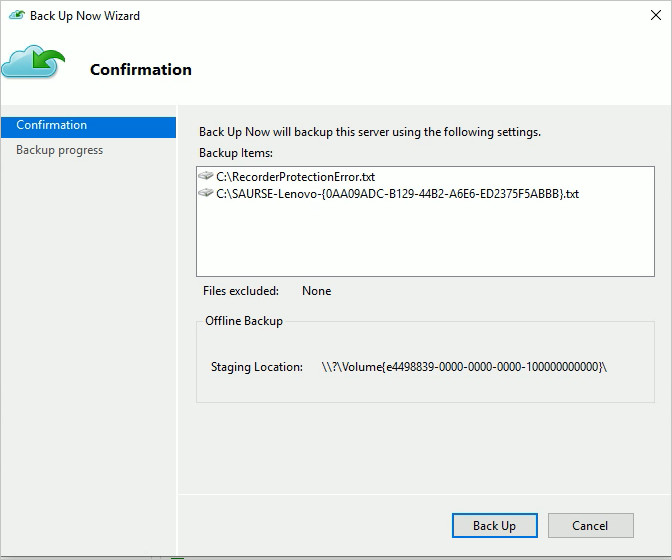
The MARS Agent starts backing up the data you selected to the Azure Data Box device. This process might take from several hours to a few days. The amount of time depends on the number of files and connection speed between the server with the MARS Agent and the Azure Data Box disk.
After the backup of the data is finished, you'll see a page on the MARS Agent that resembles this one.
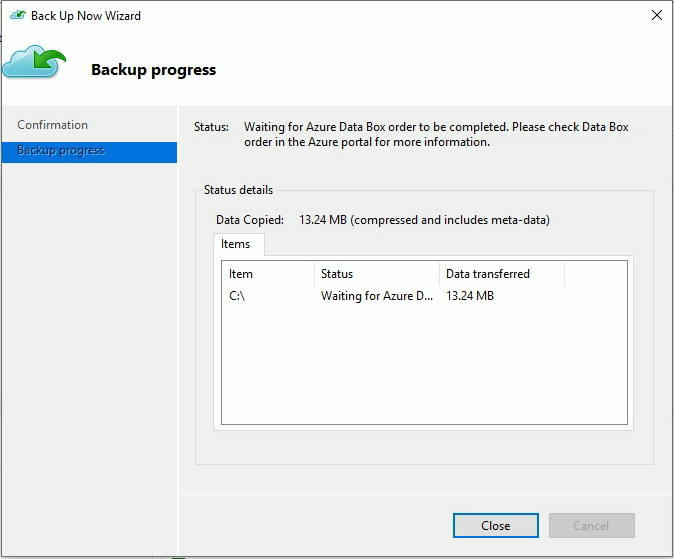
Post-backup steps
This section explains the steps to take after the backup of the data to the Azure Data Box Disk is successful.
Follow the steps in this article to ship the Azure Data Box disk to Azure. If you used an Azure Data Box 100-TB device, follow these steps to ship the Azure Data Box device to Azure.
Monitor the Data Box job in the Azure portal. After the Azure Data Box job is finished, the MARS Agent automatically moves the data from the storage account to the Recovery Services vault at the time of the next scheduled backup. It then marks the backup job as Job Completed if a recovery point is successfully created.
Note
The MARS Agent triggers backups at the times scheduled during policy creation. These jobs flag "Waiting for Azure Data Box job to be completed" until the time the job is finished.
After the MARS Agent successfully creates a recovery point that corresponds to the initial backup, you can delete the storage account or specific contents associated with the Azure Data Box job.
Troubleshooting
The Microsoft Azure Recovery Services (MARS) Agent creates a Microsoft Entra application for you in your tenant. This application requires a certificate for authentication that's created and uploaded when you configure an offline seeding policy. We use Azure PowerShell to create and upload the certificate to the Microsoft Entra application.
Problem
When you configure offline backup, you might face a problem because of a bug in the Azure PowerShell cmdlet. You might be unable to add multiple certificates to the same Microsoft Entra application created by the MAB Agent. This problem will affect you if you configured an offline seeding policy for the same or a different server.
Verify if the problem is caused by this specific root cause
To see if your problem is the same as the one previously described, do one of the following steps.
Step 1 of verification
Check to see if the following error message appears in the MAB console when you configured offline backup.
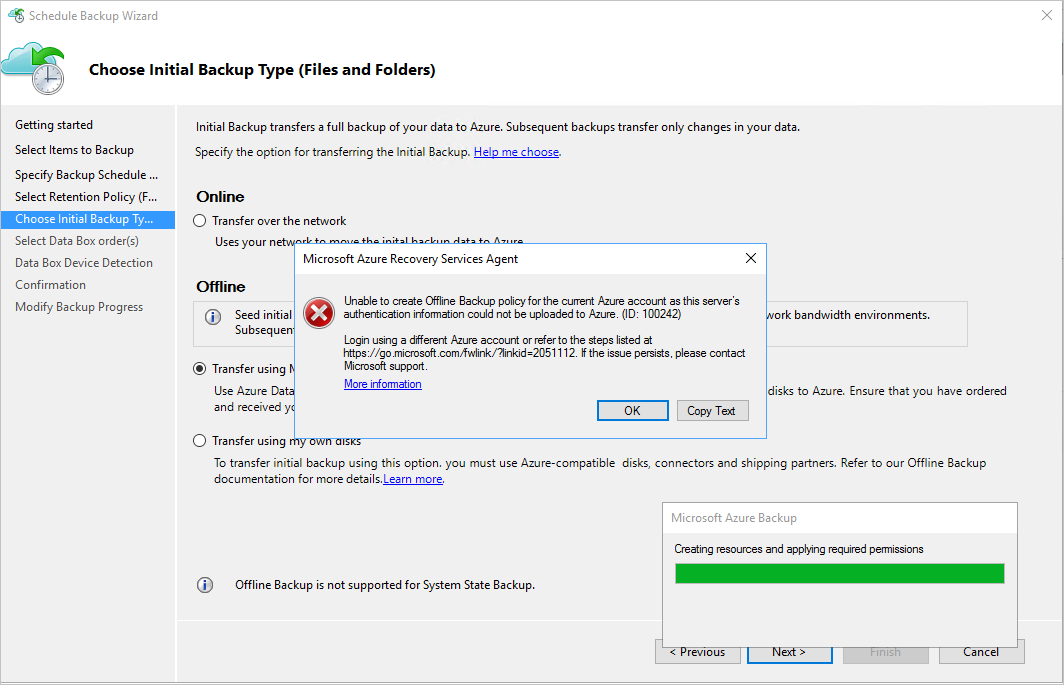
Step 2 of verification
Open the Temp folder in the installation path. The default temp folder path is C:\Program Files\Microsoft Azure Recovery Services Agent\Temp. Look for the CBUICurr file, and open the file.
In the CBUICurr file, scroll to the last line and check to see if the problem is the same as the one in this error message:
Unable to create an Azure AD application credential in customer's account. Exception: Update to existing credential with KeyId <some guid> is not allowed.
Workaround
As a workaround to resolve this problem, do the following steps and retry the policy configuration.
Step 1 of workaround
Sign in to PowerShell that appears on the MAB UI by using a different account with admin access on the subscription that will have the Data Box job created.
Step 2 of workaround
If no other server has offline seeding configured and no other server is dependent on the AzureOfflineBackup_<Azure User Id> application, delete this application. Select Azure portal > Microsoft Entra ID > App registrations.
Note
Check to see if the AzureOfflineBackup_<Azure User Id> application doesn't have any other offline seeding configured and also if no other server is dependent on this application. Go to Settings > Keys under the Public Keys section. It shouldn't have any other public keys added. See the following screenshot for reference.
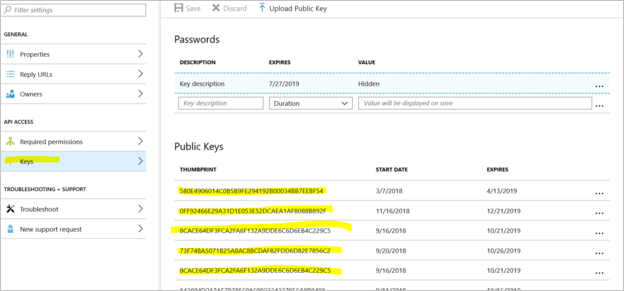
Step 3
From the server you're trying to configure for offline backup, perform the following actions.
Go to the Manage computer certificate application > Personal tab, and look for the certificate with the name
CB_AzureADCertforOfflineSeeding_<Timestamp>.Select the certificate, right-click All Tasks, and select Export without a private key in the .cer format.
Go to the Azure offline backup application mentioned in step 2. Select Settings > Keys > Upload Public Key. Upload the certificate you exported in the previous step.

In the server, open the registry by entering regedit in the run window.
Go to the registry Computer\HKEY_LOCAL_MACHINE\SOFTWARE\Microsoft\Windows Azure Backup\Config\CloudBackupProvider. Right-click CloudBackupProvider, and add a new string value with the name
AzureADAppCertThumbprint_<Azure User Id>.Note
To get the Azure user ID, perform one of these actions:
- From the Azure-connected PowerShell, run the
Get-AzureRmADUser -UserPrincipalName "Account Holder's email as defined in the portal"command. - Go to the registry path
Computer\HKEY_LOCAL_MACHINE\SOFTWARE\Microsoft\Windows Azure Backup\DbgSettings\OnlineBackupwith the name CurrentUserId.
- From the Azure-connected PowerShell, run the
Right-click the string added in the previous step, and select Modify. In the value, provide the thumbprint of the certificate you exported in step 2. Select OK.
To get the value of the thumbprint, double-click the certificate. Select the Details tab, and scroll down until you see the thumbprint field. Select Thumbprint, and copy the value.
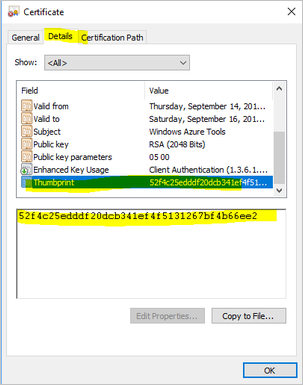
Questions
For any questions or clarifications about any problems you faced, contact AskAzureBackupTeam@microsoft.com.